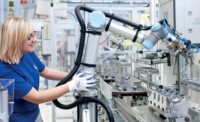It’s not science fiction: robots are invading our world in a big way. That invasion, fueled by dramatic advancements in technology that make the devices more sophisticated than ever, is resulting in their increased use in workplaces, among other spheres. With this in mind, the National Institute for Occupational Safety and Health (NIOSH) has established a virtual Center for Occupational Robotics Research that will specifically address the safety and health implications for worker-robot interactions.
“New robotics applications are fundamentally different from earlier applications in which robots were designed to operate in isolation from workers, in robotic cells or cages,” says NIOSH Director Dr. John Howard. “New classes of robots are being designed to work alongside, move among, and even be worn by human workers.”
Emerging robotics technologies include:
- Collaborative robots designed to work alongside and have coordinated tasks with human workers.
- Mobile robots that move alongside and in the same space as human workers.
- Wearable robotics designed to decrease physical loads on human workers (i.e., powered exoskeletons/exosuits).
- Remotely controlled and autonomous ground and aerial vehicles, such as tractors, rescue vehicles, commercial trucks, and drones.
Robot use began primarily in manufacturing, but it has since spread to other sectors, such as as agriculture, healthcare, transportation, warehousing, services, public safety, construction, and mining.
Howard said the new technologies hold both promise and concerns for worker safety and well-being.
“The promise is that robots will increasingly be used to do work that is dangerous for human workers, including repetitive and physically demanding work and work in dangerous and hostile environments. Concerns are based on the rapid growth of this technology, a lack of experience and potential unforeseen hazards as these technologies are deployed in varied and uncontrolled work environments, and a recognition that new strategies and systems will need to be developed and tested to ensure the safety of human workers.”
Working in partnership with academic researchers, trade associations, robotics manufacturers, employers using robotics technology, labor organizations, and other federal agencies, the Center’s will provide scientific leadership to inform the development and use of occupational robots that enhance worker safety and health.
It will:
- Monitor trends in injuries associated with robotics technologies.
- Evaluate robotics technologies as sources of, and interventions for, workplace injuries and illnesses.
- Establish risk profiles of robotics workplaces.
- Identify research needs and conduct research to improve the safety, health, and well-being of humans working with robots and robotics technologies.
- Support the development and adoption of consensus safety standards.
- Develop and communicate best practices, guidance, and training for safe interactions between human workers and robots/robotics technology.
Howard encourages safety professionals with robots in their workplaces to visit the Center’s website. It includes links to NIOSH’s seminal work on industrial robotics safety from the 1980s, recent scientific commentaries on trends in robotics and implications for worker safety, several NIOSH science blogs, and information on the Center’s first formal partnership, an Alliance with OSHA and the Robotics Industries Association.
“With new robotics technologies beginning to take off, we are at a critical juncture. It is important to proactively address worker safety and well-being now so that the promise of this technology for increased worker safety is realized.”
Anyone interested in partnering with the Center should contact Ms. Dawn Castillo or Dr. Hongwei Hsiao.



